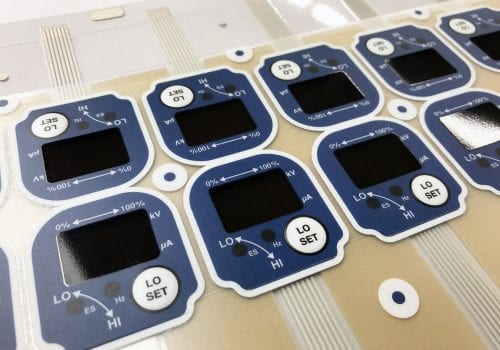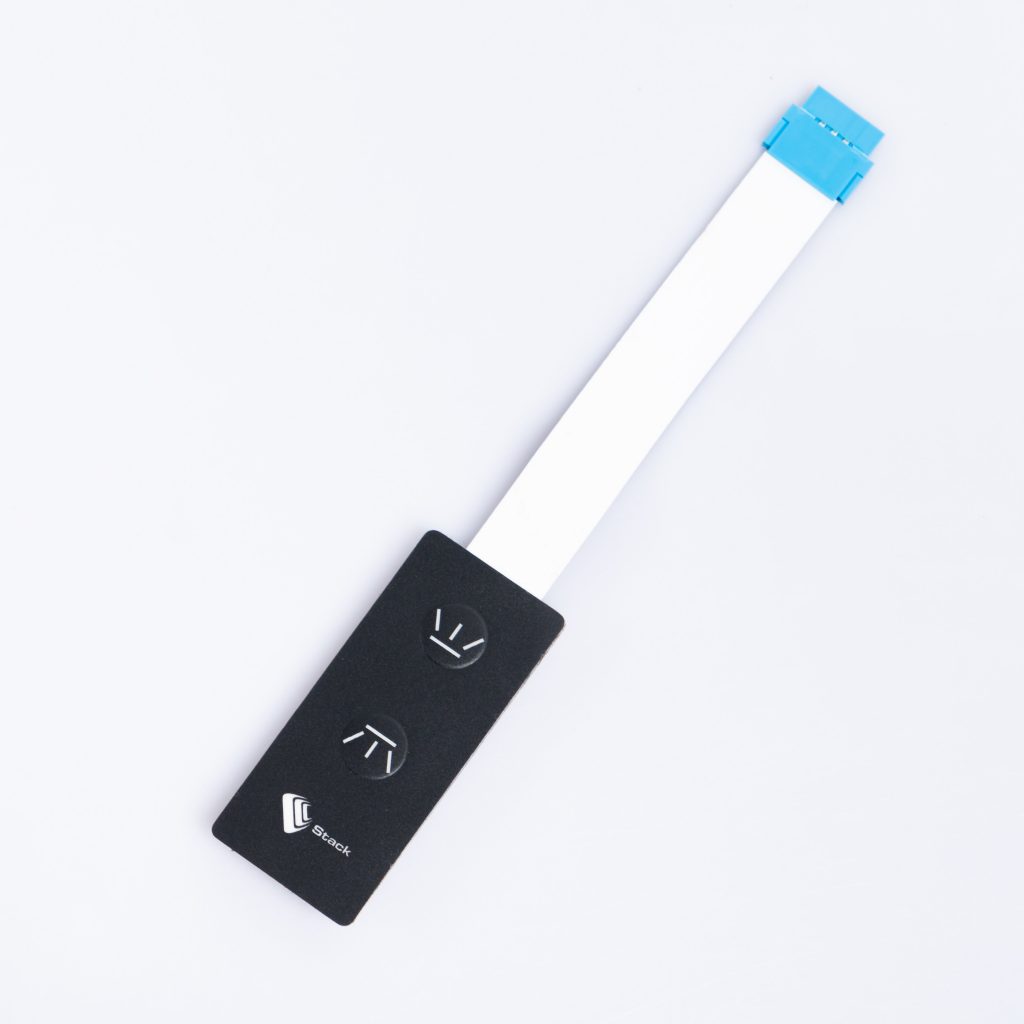Everything About Membrane layer Switch Over: A Comprehensive Guide for Beginners
Membrane layer buttons are necessary components in modern electronics, offering a special user interface for user interaction - membrane switch. Their split building, including overlays and conductive traces, offers capability and durability. Unlike standard mechanical switches, membrane switches offer a smooth layout and customizable choices. Recognizing their crucial functions and benefits can change product design. The complexities of their application and design factors to consider require additional exploration.
What Is a Membrane Switch over?
A membrane layer switch is a sort of electric switch that contains a flexible membrane layer layered over a printed motherboard. This design permits for a portable and smooth interface, typically used in different digital gadgets. Membrane buttons are commonly located in consumer devices, clinical devices, and commercial equipment because of their toughness and resistance to environmental factors.The building and construction normally consists of numerous layers, such as graphic overlays and adhesive backing, which supply tactile feedback and shield the circuitry underneath. The operation of a membrane button is started when pressure is used to the surface, completing an electric circuit.These buttons are valued for their adaptability, allowing customized styles and published graphics that cater to certain individual interfaces. Their inconspicuous nature minimizes space needs, making them perfect for applications where traditional buttons may not fit. On the whole, membrane buttons provide a useful and visual remedy for modern electronic tools.
Trick Parts of Membrane Changes
Membrane layer switches over consist of a number of key parts that add to their functionality and efficiency. The top layer, called the overlay, supplies the individual interface and is usually published with symbols or graphics. Underneath the overlay lies a spacer layer, which separates the conductive components and avoids unintentional activation. The next vital part is the visuals layer, which improves aesthetics and assures the durability of the design.Conductive traces, typically made from materials like silver or carbon, are published on the circuit layer. When pressure is put on the overlay, these traces enter contact, finishing the circuit. Furthermore, a backing layer offers architectural assistance and can be made from products such as polyester or polycarbonate. With each other, these elements develop a reputable, straightforward user interface suitable for different applications, from household devices to commercial devices. Comprehending these elements is essential for anybody curious about membrane layer button innovation.
Just How Membrane Switches Job
Comprehending how membrane layer switches function is vital for valuing their extensive usage in different gadgets. A membrane layer button operates via a series of layers, including a visuals overlay, spacer, and a circuit layer. When pressure is put on the overlay, it presses the spacer layer, allowing the circuit layer to make get in touch with and finish an electric circuit. This activity sends a signal to the gadget, prompting a feedback, such as turning on a light or triggering a function.Membrane switches can be developed with different attributes, including responsive responses, backlighting, and personalized graphics, boosting user interaction. Their building and construction permits for a sealed layout, safeguarding the interior components from dust, moisture, and contaminants. This durability makes them ideal for varied applications, from consumer electronic devices to commercial devices. Generally, the simplicity and effectiveness of membrane switches contribute to their popularity in modern technology.
Advantages of Membrane Switches Mechanical Buttons
While mechanical buttons have actually long been a staple in several tools, membrane layer changes offer distinct advantages that make them progressively appealing. One substantial advantage is their slim account, permitting even more compact styles and greater flexibility in product development. In addition, membrane switches function an uniform surface, which enhances visual allure and simplifies cleaning, making them suitable for environments where hygiene is critical.Another benefit is their resistance to dust and moisture. Unlike mechanical buttons, which can be compromised by ecological factors, membrane layer switches supply a sealed interface that protects against contaminants - membrane switch. Membrane layer buttons typically have a longer lifespan due to fewer moving components, resulting in boosted longevity and reliability.Cost-effectiveness is also a remarkable benefit, as membrane switches can be generated in mass with reduced manufacturing prices. These factors integrate to position membrane layer switches as a useful option to conventional mechanical choices in different applications
Usual Applications of Membrane Changes
Membrane switches are commonly made use of in numerous markets, particularly in consumer electronics and industrial control board. In customer gadgets, they offer a sleek, user-friendly interface, while in commercial settings, they improve resilience and functionality. Understanding these applications highlights the adaptability and functionality of membrane layer switches in modern-day innovation.
Consumer Electronic Devices Tools
As consumer electronic devices remain to progress, membrane buttons have become a preferred option for a variety of devices due to their convenience and smooth design. These buttons are typically discovered in smart devices, tablet computers, and remotes, where room is limited and appearances issue. Their reduced profile and adjustable styles permit makers to create user-friendly user interfaces that boost the total user experience. Additionally, membrane switches are typically used in devices such as microwaves and coffee manufacturers, supplying instinctive control options while standing up to dampness and dirt. The longevity and reliability of membrane layer switches over make them ideal for day-to-day consumer products, making certain durability and constant efficiency. In general, their combination in customer electronic devices shows a mix of functionality and contemporary layout.
Industrial Control Panels
The applications of membrane layer changes extend past consumer electronic devices, discovering substantial usage in industrial control panels. These buttons are preferred for their sturdiness and resistance to extreme environments, making them perfect for making and process control settings. They offer a trustworthy interface for drivers to control machinery, monitor have a peek at this website processes, and readjust settings. Membrane layer switches can be customized to suit details operational needs, integrating functions like backlighting and responsive feedback, boosting customer experience. Their low-profile layout permits for combination right into different devices, while their ability to endure spills, dust, and extreme temperature levels assurances long life. On the whole, membrane layer switches add to secure and reliable procedure in commercial applications, showing their convenience and effectiveness in demanding settings.
Factors To Consider for Creating Membrane Changes
When creating membrane layer switches, selecting the ideal products is necessary to assure durability and performance. Additionally, recognizing layer configuration techniques can substantially impact the button's efficiency and individual experience. These factors to consider play an essential role in producing reliable and efficient membrane layer button designs.
Product Choice Relevance
Material option plays an essential function in the layout and functionality of membrane switches. The chosen materials directly influence the button's toughness, tactile feedback, and total visual. Secret considerations include the substratum, which have to supply architectural stability while permitting adaptability, and the visuals overlay, which requires to be immune to put on and environmental elements. Conductive materials ought to assure trusted electric efficiency, while adhesives must provide strong bonding without endangering the button's operation. Furthermore, compatibility with producing processes and end-user settings is crucial; products need to stand up to varying temperature levels, humidity degrees, and chemical exposure. Inevitably, ideal product option not just improves the membrane switch's performance yet additionally adds to its long life read here and individual contentment, making it a crucial aspect of the design procedure.

Layer Arrangement Methods

Frequently Asked Concerns
How Long Do Membrane Switches Normally Last?
Membrane switches usually have a life expectancy of 1 to 5 million cycles, depending upon use and environmental conditions. Factors such as style high quality and operating frequency greatly affect their sturdiness and total efficiency long life.

Can Membrane Changes Be Customized for Specific Layouts?
Membrane switches can undoubtedly be customized to fit details designs, permitting diverse forms, shades, and functionalities. This convenience enables makers to customize these buttons to satisfy distinct aesthetic and functional needs successfully.
What Products Are Used in Membrane Change Construction?
Membrane switches are usually built using materials such as polyester, polycarbonate, and adhesive layers. These products offer resistance, toughness, and versatility to environmental elements, ensuring the switches work effectively in various applications and conditions.
Are Membrane Layer Switches Over Water-proof or Resistant to Wetness?
Membrane buttons can be made to be moisture-resistant, utilizing specialized products and finishings. Nevertheless, their water-proof capabilities rely on building top quality and details applications, making it vital to evaluate requirements for excellent efficiency in different atmospheres.
Exactly How Are Membrane Switches Over Fixed if Harmed?
Repairing damaged membrane layer switches generally involves replacing the impacted layer or circuit. Service technicians may additionally use conductive glue or use specialized fixing sets, guaranteeing capability is restored without total substitute of the whole you can find out more button setting up. Unlike typical mechanical buttons, membrane layer buttons offer a streamlined style and adjustable alternatives. A membrane layer switch is a kind of electric switch that is composed of an adaptable membrane layered over a published circuit board. The procedure of a membrane switch is initiated when pressure is applied to the surface area, finishing an electric circuit.These buttons are valued for their versatility, making it possible for customized layouts and printed graphics that provide to particular user interfaces. While mechanical switches have long been a staple in several gadgets, membrane layer switches deal unique benefits that make them significantly appealing. Membrane layer buttons normally have a longer lifespan due to less moving parts, resulting in enhanced durability and reliability.Cost-effectiveness is also a notable advantage, as membrane switches can be generated in mass with lower production expenses.